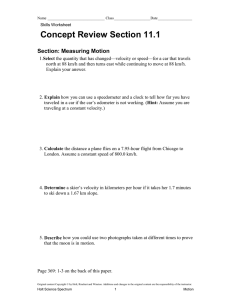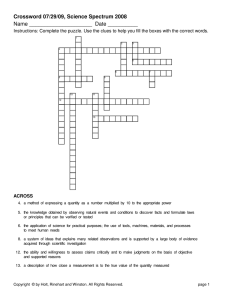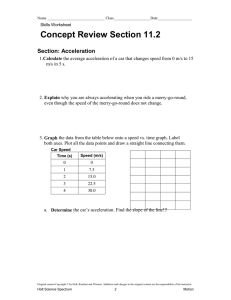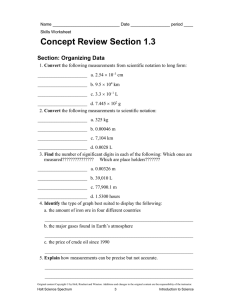Resources Chapter Presentation Visual Concepts Sample Problems
advertisement
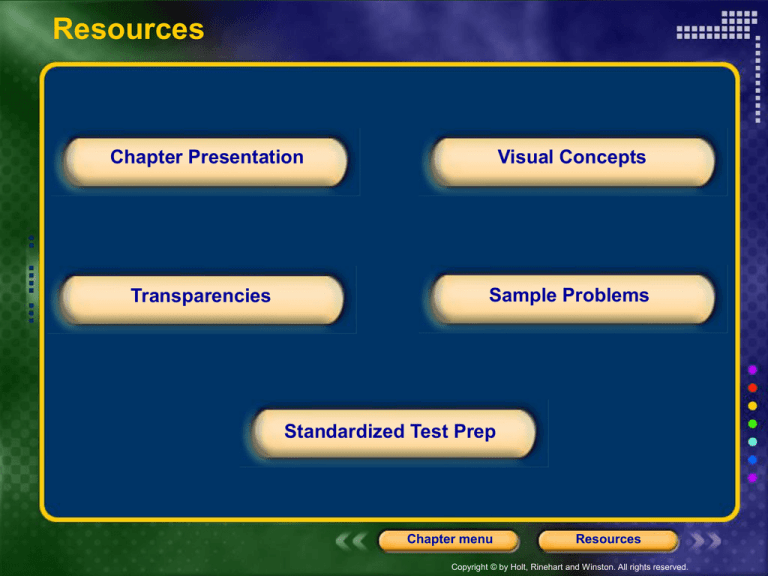
Resources Chapter Presentation Transparencies Visual Concepts Sample Problems Standardized Test Prep Chapter menu Resources Copyright © by Holt, Rinehart and Winston. All rights reserved. Chapter 2: displacement http://www.khanacademy.org/scie nce/physics/one-dimensionalmotion/displacement-velocitytime/v/introduction-to-vectors-andscalars Chapter menu Resources Copyright © by Holt, Rinehart and Winston. All rights reserved. Chapter 2 Motion in One Dimension Table of Contents Section 1 Displacement and Velocity Section 2 Acceleration Section 3 Falling Objects Chapter menu Resources Copyright © by Holt, Rinehart and Winston. All rights reserved. Chapter 2 Section 1 Displacement and Velocity Objectives • Describe motion in terms of frame of reference, displacement, time, and velocity. • Calculate the displacement of an object traveling at a known velocity for a specific time interval. • Construct and interpret graphs of position versus time. Chapter menu Resources Copyright © by Holt, Rinehart and Winston. All rights reserved. Chapter 2 Section 1 Displacement and Velocity One Dimensional Motion • To simplify the concept of motion, we will first consider motion that takes place in one direction. • One example is the motion of a commuter train on a straight track. • To measure motion, you must choose a frame of reference. A frame of reference is a system for specifying the precise location of objects in space and time. Chapter menu Resources Copyright © by Holt, Rinehart and Winston. All rights reserved. Chapter 2 Section 1 Displacement and Velocity Frame of Reference Chapter menu Resources Copyright © by Holt, Rinehart and Winston. All rights reserved. Chapter 2 Section 1 Displacement and Velocity Displacement • Displacement is a change in position. • Displacement is not always equal to the distance traveled. • The SI unit of displacement is the meter, m. Dx = xf – xi displacement = final position – initial position Chapter menu Resources Copyright © by Holt, Rinehart and Winston. All rights reserved. Chapter 2 Section 1 Displacement and Velocity Displacement Chapter menu Resources Copyright © by Holt, Rinehart and Winston. All rights reserved. Chapter 2 Section 1 Displacement and Velocity Positive and Negative Displacements Chapter menu Resources Copyright © by Holt, Rinehart and Winston. All rights reserved. Chapter 2 Section 1 Displacement and Velocity Average Velocity • Average velocity is the total displacement divided by the time interval during which the displacement occurred. vavg Dx x f xi Dt t f ti change in position displacement average velocity = = change in time time interval • In SI, the unit of velocity is meters per second, abbreviated as m/s. Chapter menu Resources Copyright © by Holt, Rinehart and Winston. All rights reserved. Chapter 2 Section 1 Displacement and Velocity Average Velocity Chapter menu Resources Copyright © by Holt, Rinehart and Winston. All rights reserved. Chapter 2 Section 1 Displacement and Velocity Velocity and Speed • Velocity describes motion with both a direction and a numerical value (a magnitude). • Speed has no direction, only magnitude. • Average speed is equal to the total distance traveled divided by the time interval. distance traveled average speed = time of travel Chapter menu Resources Copyright © by Holt, Rinehart and Winston. All rights reserved. Chapter 2 Section 1 Displacement and Velocity Interpreting Velocity Graphically • For any position-time graph, we can determine the average velocity by drawing a straight line between any two points on the graph. • If the velocity is constant, the graph of position versus time is a straight line. The slope indicates the velocity. – Object 1: positive slope = positive velocity – Object 2: zero slope= zero velocity – Object 3: negative slope = negative velocity Chapter menu Resources Copyright © by Holt, Rinehart and Winston. All rights reserved. Chapter 2 Section 1 Displacement and Velocity Interpreting Velocity Graphically, continued The instantaneous velocity is the velocity of an object at some instant or at a specific point in the object’s path. The instantaneous velocity at a given time can be determined by measuring the slope of the line that is tangent to that point on the position-versus-time graph. Chapter menu Resources Copyright © by Holt, Rinehart and Winston. All rights reserved. Chapter 2 Section 1 Displacement and Velocity Sign Conventions for Velocity Chapter menu Resources Copyright © by Holt, Rinehart and Winston. All rights reserved. Chapter 2 Section 2 Acceleration Objectives • Describe motion in terms of changing velocity. • Compare graphical representations of accelerated and nonaccelerated motions. • Apply kinematic equations to calculate distance, time, or velocity under conditions of constant acceleration. Chapter menu Resources Copyright © by Holt, Rinehart and Winston. All rights reserved. Chapter 2 Section 2 Acceleration Changes in Velocity • Acceleration is the rate at which velocity changes over time. aavg Dv v f vi Dt t f ti change in velocity average acceleration = time required for change • An object accelerates if its speed, direction, or both change. • Acceleration has direction and magnitude. Thus, acceleration is a vector quantity. Chapter menu Resources Copyright © by Holt, Rinehart and Winston. All rights reserved. Chapter 2 Section 2 Acceleration Acceleration Chapter menu Resources Copyright © by Holt, Rinehart and Winston. All rights reserved. Chapter 2 Section 2 Acceleration Changes in Velocity, continued • Consider a train moving to the right, so that the displacement and the velocity are positive. • The slope of the velocity-time graph is the average acceleration. – When the velocity in the positive direction is increasing, the acceleration is positive, as at A. – When the velocity is constant, there is no acceleration, as at B. – When the velocity in the positive direction is decreasing, the acceleration is negative, as at C. Chapter menu Resources Copyright © by Holt, Rinehart and Winston. All rights reserved. Chapter 2 Section 2 Acceleration Graphical Representations of Acceleration Chapter menu Resources Copyright © by Holt, Rinehart and Winston. All rights reserved. Chapter 2 Section 2 Acceleration Velocity and Acceleration Chapter menu Resources Copyright © by Holt, Rinehart and Winston. All rights reserved. Chapter 2 Section 2 Acceleration Motion with Constant Acceleration • When velocity changes by the same amount during each time interval, acceleration is constant. • The relationships between displacement, time, velocity, and constant acceleration are expressed by the equations shown on the next slide. These equations apply to any object moving with constant acceleration. • These equations use the following symbols: Dx = displacement vi = initial velocity vf = final velocity Dt = time interval Chapter menu Resources Copyright © by Holt, Rinehart and Winston. All rights reserved. Chapter 2 Section 2 Acceleration Equations for Constantly Accelerated Straight-Line Motion Chapter menu Resources Copyright © by Holt, Rinehart and Winston. All rights reserved. Chapter 2 Section 2 Acceleration Sample Problem Final Velocity After Any Displacement A person pushing a stroller starts from rest, uniformly accelerating at a rate of 0.500 m/s2. What is the velocity of the stroller after it has traveled 4.75 m? Chapter menu Resources Copyright © by Holt, Rinehart and Winston. All rights reserved. Chapter 2 Section 2 Acceleration Sample Problem, continued 1. Define Given: vi = 0 m/s a = 0.500 m/s2 Dx = 4.75 m Unknown: vf = ? Diagram: Choose a coordinate system. The most convenient one has an origin at the initial location of the stroller, as shown above. The positive direction is to the right. Chapter menu Resources Copyright © by Holt, Rinehart and Winston. All rights reserved. Chapter 2 Section 2 Acceleration Sample Problem, continued 2. Plan Choose an equation or situation: Because the initial velocity, acceleration, and displacement are known, the final velocity can be found using the following equation: v f 2 vi 2 2aDx Rearrange the equation to isolate the unknown: Take the square root of both sides to isolate vf . v f vi 2 2aDx Chapter menu Resources Copyright © by Holt, Rinehart and Winston. All rights reserved. Chapter 2 Section 2 Acceleration Sample Problem, continued 3. Calculate Substitute the values into the equation and solve: v f (0 m/s)2 2(0.500 m/s2 )(4.75 m) v f 2.18 m/s 4. Evaluate Tip: Think about the physical situation to determine whether to keep the positive or negative answer from the square root. In this case, the stroller starts from rest and ends with a speed of 2.18 m/s. An object that is speeding up and has a positive acceleration must have a positive velocity. So, the final velocity must be positive. The stroller’s velocity after accelerating for 4.75 m is 2.18 m/s to the right. Chapter menu Resources Copyright © by Holt, Rinehart and Winston. All rights reserved. Chapter 2 Section 3 Falling Objects Objectives • Relate the motion of a freely falling body to motion with constant acceleration. • Calculate displacement, velocity, and time at various points in the motion of a freely falling object. • Compare the motions of different objects in free fall. Chapter menu Resources Copyright © by Holt, Rinehart and Winston. All rights reserved. Chapter 2 Section 3 Falling Objects Free Fall Chapter menu Resources Copyright © by Holt, Rinehart and Winston. All rights reserved. Chapter 2 Section 3 Falling Objects Free Fall • Free fall is the motion of a body when only the force due to gravity is acting on the body. • The acceleration on an object in free fall is called the acceleration due to gravity, or free-fall acceleration. • Free-fall acceleration is denoted with the symbols ag (generally) or g (on Earth’s surface). Chapter menu Resources Copyright © by Holt, Rinehart and Winston. All rights reserved. Chapter 2 Section 3 Falling Objects Free-Fall Acceleration Chapter menu Resources Copyright © by Holt, Rinehart and Winston. All rights reserved. Chapter 2 Section 3 Falling Objects Free-Fall Acceleration • Free-fall acceleration is the same for all objects, regardless of mass. • This book will use the value g = 9.81 m/s2. • Free-fall acceleration on Earth’s surface is –9.81 m/s2 at all points in the object’s motion. • Consider a ball thrown up into the air. – Moving upward: velocity is decreasing, acceleration is – 9.81 m/s2 – Top of path: velocity is zero, acceleration is –9.81 m/s2 – Moving downward: velocity is increasing, acceleration is – 9.81 m/s2 Chapter menu Resources Copyright © by Holt, Rinehart and Winston. All rights reserved. Chapter 2 Section 3 Falling Objects Velocity and Acceleration of an Object in Free Fall Chapter menu Resources Copyright © by Holt, Rinehart and Winston. All rights reserved. Chapter 2 Section 3 Falling Objects Sample Problem Falling Object Jason hits a volleyball so that it moves with an initial velocity of 6.0 m/s straight upward. If the volleyball starts from 2.0 m above the floor, how long will it be in the air before it strikes the floor? Chapter menu Resources Copyright © by Holt, Rinehart and Winston. All rights reserved. Chapter 2 Section 3 Falling Objects Sample Problem, continued 1. Define Given: vi = +6.0 m/s a = –g = –9.81 m/s2 Dy = –2.0 m Unknown: Dt = ? Diagram: Place the origin at the Starting point of the ball (yi = 0 at ti = 0). Chapter menu Resources Copyright © by Holt, Rinehart and Winston. All rights reserved. Chapter 2 Section 3 Falling Objects Sample Problem, continued 2. Plan Choose an equation or situation: Both ∆t and vf are unknown. Therefore, first solve for vf using the equation that does not require time. Then, the equation for vf that does involve time can be used to solve for ∆t. v f 2 vi 2 2aDy v f vi a Dt Rearrange the equation to isolate the unknown: Take the square root of the first equation to isolate vf. The second equation must be rearranged to solve for ∆t. v f vi 2aDy 2 Dt v f vi Chapter menu a Resources Copyright © by Holt, Rinehart and Winston. All rights reserved. Chapter 2 Section 3 Falling Objects Sample Problem, continued 3. Calculate Substitute the values into the equation and solve: First find the velocity of the ball at the moment that it hits the floor. v f vi 2 2aDy (6.0 m/s)2 2(–9.81 m/s2 )(–2.0 m) v f 36 m2 /s2 39 m2 /s2 75 m2 /s2 –8.7 m/s Tip: When you take the square root to find vf , select the negative answer because the ball will be moving toward the floor, in the negative direction. Chapter menu Resources Copyright © by Holt, Rinehart and Winston. All rights reserved. Chapter 2 Section 3 Falling Objects Sample Problem, continued Next, use this value of vf in the second equation to solve for ∆t. Dt v f vi a –8.7 m/s 6.0 m/s –14.7 m/s 2 –9.81 m/s –9.81 m/s 2 Dt 1.50 s 4. Evaluate The solution, 1.50 s, is a reasonable amount of time for the ball to be in the air. Chapter menu Resources Copyright © by Holt, Rinehart and Winston. All rights reserved. Chapter 2 Standardized Test Prep Multiple Choice Use the graphs to answer questions 1–3. 1. Which graph represents an object moving with a constant positive velocity? A. I B. II C. III D. IV Chapter menu Resources Copyright © by Holt, Rinehart and Winston. All rights reserved. Chapter 2 Standardized Test Prep Multiple Choice Use the graphs to answer questions 1–3. 1. Which graph represents an object moving with a constant positive velocity? A. I B. II C. III D. IV Chapter menu Resources Copyright © by Holt, Rinehart and Winston. All rights reserved. Chapter 2 Standardized Test Prep Multiple Choice, continued Use the graphs to answer questions 1–3. 2. Which graph represents an object at rest? F. I G. II H. III J. IV Chapter menu Resources Copyright © by Holt, Rinehart and Winston. All rights reserved. Chapter 2 Standardized Test Prep Multiple Choice, continued Use the graphs to answer questions 1–3. 2. Which graph represents an object at rest? F. I G. II H. III J. IV Chapter menu Resources Copyright © by Holt, Rinehart and Winston. All rights reserved. Chapter 2 Standardized Test Prep Multiple Choice, continued Use the graphs to answer questions 1–3. 3. Which graph represents an object moving with a constant positive acceleration? A. I B. II C. III D. IV Chapter menu Resources Copyright © by Holt, Rinehart and Winston. All rights reserved. Chapter 2 Standardized Test Prep Multiple Choice, continued Use the graphs to answer questions 1–3. 3. Which graph represents an object moving with a constant positive acceleration? A. I B. II C. III D. IV Chapter menu Resources Copyright © by Holt, Rinehart and Winston. All rights reserved. Chapter 2 Standardized Test Prep Multiple Choice, continued 4. A bus travels from El Paso, Texas, to Chihuahua, Mexico, in 5.2 h with an average velocity of 73 km/h to the south.What is the bus’s displacement? F. 73 km to the south G. 370 km to the south H. 380 km to the south J. 14 km/h to the south Chapter menu Resources Copyright © by Holt, Rinehart and Winston. All rights reserved. Chapter 2 Standardized Test Prep Multiple Choice, continued 4. A bus travels from El Paso, Texas, to Chihuahua, Mexico, in 5.2 h with an average velocity of 73 km/h to the south.What is the bus’s displacement? F. 73 km to the south G. 370 km to the south H. 380 km to the south J. 14 km/h to the south Chapter menu Resources Copyright © by Holt, Rinehart and Winston. All rights reserved. Chapter 2 Standardized Test Prep Multiple Choice, continued Use the position-time graph of a squirrel running along a clothesline to answer questions 5–6. 5. What is the squirrel’s displacement at time t = 3.0 s? A. –6.0 m B. –2.0 m C. +0.8 m D. +2.0 m Chapter menu Resources Copyright © by Holt, Rinehart and Winston. All rights reserved. Chapter 2 Standardized Test Prep Multiple Choice, continued Use the position-time graph of a squirrel running along a clothesline to answer questions 5–6. 5. What is the squirrel’s displacement at time t = 3.0 s? A. –6.0 m B. –2.0 m C. +0.8 m D. +2.0 m Chapter menu Resources Copyright © by Holt, Rinehart and Winston. All rights reserved. Chapter 2 Standardized Test Prep Multiple Choice, continued Use the position-time graph of a squirrel running along a clothesline to answer questions 5–6. 6. What is the squirrel’s average velocity during the time interval between 0.0 s and 3.0 s? F. –2.0 m/s G. –0.67 m/s H. 0.0 m/s J. +0.53 m/s Chapter menu Resources Copyright © by Holt, Rinehart and Winston. All rights reserved. Chapter 2 Standardized Test Prep Multiple Choice, continued Use the position-time graph of a squirrel running along a clothesline to answer questions 5–6. 6. What is the squirrel’s average velocity during the time interval between 0.0 s and 3.0 s? F. –2.0 m/s G. –0.67 m/s H. 0.0 m/s J. +0.53 m/s Chapter menu Resources Copyright © by Holt, Rinehart and Winston. All rights reserved. Chapter 2 Standardized Test Prep Multiple Choice, continued 7. Which of the following statements is true of acceleration? A. Acceleration always has the same sign as displacement. B. Acceleration always has the same sign as velocity. C. The sign of acceleration depends on both the direction of motion and how the velocity is changing. D. Acceleration always has a positive sign. • Chapter menu Resources Copyright © by Holt, Rinehart and Winston. All rights reserved. Chapter 2 Standardized Test Prep Multiple Choice, continued 7. Which of the following statements is true of acceleration? A. Acceleration always has the same sign as displacement. B. Acceleration always has the same sign as velocity. C. The sign of acceleration depends on both the direction of motion and how the velocity is changing. D. Acceleration always has a positive sign. • Chapter menu Resources Copyright © by Holt, Rinehart and Winston. All rights reserved. Chapter 2 Standardized Test Prep Multiple Choice, continued 8. A ball initially at rest rolls down a hill and has an acceleration of 3.3 m/s2. If it accelerates for 7.5 s, how far will it move during this time? F. 12 m G. 93 m H. 120 m J. 190 m Chapter menu Resources Copyright © by Holt, Rinehart and Winston. All rights reserved. Chapter 2 Standardized Test Prep Multiple Choice, continued 8. A ball initially at rest rolls down a hill and has an acceleration of 3.3 m/s2. If it accelerates for 7.5 s, how far will it move during this time? F. 12 m G. 93 m H. 120 m J. 190 m Chapter menu Resources Copyright © by Holt, Rinehart and Winston. All rights reserved. Chapter 2 Standardized Test Prep Multiple Choice, continued 9. Which of the following statements is true for a ball thrown vertically upward? A. The ball has a negative acceleration on the way up and a positive acceleration on the way down. B. The ball has a positive acceleration on the way up and a negative acceleration on the way down. C. The ball has zero acceleration on the way up and a positive acceleration on the way down. D. The ball has a constant acceleration throughout its flight. Chapter menu Resources Copyright © by Holt, Rinehart and Winston. All rights reserved. Chapter 2 Standardized Test Prep Multiple Choice, continued 9. Which of the following statements is true for a ball thrown vertically upward? A. The ball has a negative acceleration on the way up and a positive acceleration on the way down. B. The ball has a positive acceleration on the way up and a negative acceleration on the way down. C. The ball has zero acceleration on the way up and a positive acceleration on the way down. D. The ball has a constant acceleration throughout its flight. Chapter menu Resources Copyright © by Holt, Rinehart and Winston. All rights reserved. Chapter 2 Standardized Test Prep Short Response 10. In one or two sentences, explain the difference between displacement and distance traveled. Chapter menu Resources Copyright © by Holt, Rinehart and Winston. All rights reserved. Chapter 2 Standardized Test Prep Short Response 10. In one or two sentences, explain the difference between displacement and distance traveled. Answer: Displacement measures only the net change in position from starting point to end point. The distance traveled is the total length of the path followed from starting point to end point and may be greater than or equal to the displacement. Chapter menu Resources Copyright © by Holt, Rinehart and Winston. All rights reserved. Chapter 2 Standardized Test Prep Short Response, continued 11. The graph shows the position of a runner at different times during a run. Use the graph to determine the runner’s displacement and average velocity: a. for the time interval from t = 0.0 min to t = 10.0 min b. for the time interval from t = 10.0 min to t = 20.0 min c. for the time interval from t = 20.0 min to t = 30.0 min d. for the entire run Chapter menu Resources Copyright © by Holt, Rinehart and Winston. All rights reserved. Chapter 2 Standardized Test Prep Short Response, continued 11. The graph shows the position of a runner at different times during a run. Use the graph to determine the runner’s displacement and average velocity. Answers will vary but should be approximately as follows: a. for t = 0.0 min to t = 10.0 min Answer: +2400 m, +4.0 m/s b. for t = 10.0 min to t = 20.0 min Answer: +1500 m, +2.5 m/s c. for t = 20.0 min to t = 30.0 min Answer: +900 m, +2 m/s d. for the entire run Answer: +4800 m, +2.7 m/s Chapter menu Resources Copyright © by Holt, Rinehart and Winston. All rights reserved. Chapter 2 Standardized Test Prep Short Response, continued 12. For an object moving with constant negative acceleration, draw the following: a. a graph of position vs. time b. a graph of velocity vs. time For both graphs, assume the object starts with a positive velocity and a positive displacement from the origin. Chapter menu Resources Copyright © by Holt, Rinehart and Winston. All rights reserved. Chapter 2 Standardized Test Prep Short Response, continued 12. For an object moving with constant negative acceleration, draw the following: a. a graph of position vs. time b. a graph of velocity vs. time For both graphs, assume the object starts with a positive velocity and a positive displacement from the origin. Answers: Chapter menu Resources Copyright © by Holt, Rinehart and Winston. All rights reserved. Chapter 2 Standardized Test Prep Short Response, continued 13. A snowmobile travels in a straight line. The snowmobile’s initial velocity is +3.0 m/s. a. If the snowmobile accelerates at a rate of +0.50 m/s2 for 7.0 s, what is its final velocity? b. If the snowmobile accelerates at the rate of –0.60 m/s2 from its initial velocity of +3.0 m/s, how long will it take to reach a complete stop? Chapter menu Resources Copyright © by Holt, Rinehart and Winston. All rights reserved. Chapter 2 Standardized Test Prep Short Response, continued 13. A snowmobile travels in a straight line. The snowmobile’s initial velocity is +3.0 m/s. a. If the snowmobile accelerates at a rate of +0.50 m/s2 for 7.0 s, what is its final velocity? b. If the snowmobile accelerates at the rate of –0.60 m/s2 from its initial velocity of +3.0 m/s, how long will it take to reach a complete stop? Answers: a. +6.5 m/s b. 5.0 s Chapter menu Resources Copyright © by Holt, Rinehart and Winston. All rights reserved. Chapter 2 Standardized Test Prep Extended Response 14. A car moving eastward along a straight road increases its speed uniformly from 16 m/s to 32 m/s in 10.0 s. a. What is the car’s average acceleration? b. What is the car’s average velocity? c. How far did the car move while accelerating? Show all of your work for these calculations. Chapter menu Resources Copyright © by Holt, Rinehart and Winston. All rights reserved. Chapter 2 Standardized Test Prep Extended Response 14. A car moving eastward along a straight road increases its speed uniformly from 16 m/s to 32 m/s in 10.0 s. a. What is the car’s average acceleration? b. What is the car’s average velocity? c. How far did the car move while accelerating? Answers: a. 1.6 m/s2 eastward b. 24 m/s c. 240 m Chapter menu Resources Copyright © by Holt, Rinehart and Winston. All rights reserved. Chapter 2 Standardized Test Prep Extended Response, continued 15. A ball is thrown vertically upward with a speed of 25.0 m/s from a height of 2.0 m. a. How long does it take the ball to reach its highest point? b. How long is the ball in the air? Show all of your work for these calculations. Chapter menu Resources Copyright © by Holt, Rinehart and Winston. All rights reserved. Chapter 2 Standardized Test Prep Extended Response, continued 15. A ball is thrown vertically upward with a speed of 25.0 m/s from a height of 2.0 m. a. How long does it take the ball to reach its highest point? b. How long is the ball in the air? Show all of your work for these calculations. Answers: a. 2.55 s b. 5.18 s Chapter menu Resources Copyright © by Holt, Rinehart and Winston. All rights reserved.

